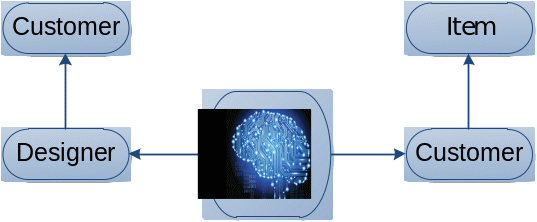The paper at hand is aimed at analyzing the impact that the innovations in the artificial intelligence (AI) field are likely to have on the fashion industry in general, and supply chain management, in particular.
The paper provides a brief overview of the problem and offers a summary of the research results. The data for the research was retrieved from popular online platforms such as Just-Style and The Business of Fashion as well as from the credible web periodicals – The New York Times and The Wall Street Journal.
The report does not only elucidate the collected findings but provides their thorough analysis and evaluates the potential outcomes.
Selected Issue
On the face of it, AI has little to do with the world of fashion. In the meantime, the innovative technologies designed in this field can have an adverse impact on this industry. Thus, at the current point, one of the key concerns of the supply chain management in fashion resides in maximizing the simplicity and efficiency of the data monitoring. In other words, fashion producers are, first and foremost, interested in gathering all the relevant data concerning a particular item on the entire way of its travel through the supply chain.
The information that is associated with consumers’ behavior is particularly valuable. Once a designer learns about the increased demand for a peculiar item, he or she has a chance to organize a prompt delivery of these items to the relevant store. However, there is still a long way between a designer and a customer. What AI suggests is a direct access and tracking of customers’ behavior by designers and merchandisers. Otherwise stated, it suggests adapting supply to the demand at the maximum. As a result, it is expected that this change will affect all the groups of stakeholders.
Research
Findings
First and foremost, it is essential to point out that technologies have always interfered in the fashion business. Thus, for example, the appearance of the so-called e-commerce has become an acute problem for supply chain managers. The clients are now accustomed to buying the low-cost garment and do not want to assess critically the expenses that a company bears due to the shipment. Online platforms, in their turn, are not always responsible enough offering fake brand clothes at incredibly low costs. Some recognizable brands, such as Michael Kors, have already announced their discontent associated with e-commerce spoiling their image (Page par.5).
The issue described above signifies that the gap between a designer and a customer is rather significant. As a result, the fashion industry has to search for alternative solutions in order to eliminate this problem.
In addition, it should be noted that the gap between fashion and innovative hi-tech, in its turn, is reducing rapidly. It seems that the fashion industry does not intend to stand on the sidelines of the progress. The most valid proof of this statement is the anticipated exhibition “Manus x Machina” that is about to take place at the Metropolitan Museum of Art (Borrelli-Persson par.1).
Even though the exhibition is devoted to the innovative changes that take place in the items’ design and production rather than to their sourcing, it still signifies the shift to the new strategies and prospects. Otherwise stated, the world of fashion announces, in such a manner, its readiness to be up-to-date from the high-tech perspective.
Whereas the exhibition is only an outline of the targeted benchmarks, some fashion players already take attempts to contribute to the AI implementation in the supply chain management. Hence, for example, Decoded Fashion is one of those companies the key objective of which resides in helping other players in the fashion market get accustomed to the modern technologies and learn to use them in a most beneficial manner. The company has already launched a series of innovative programs that help to align designers to the fabric producers. In fact, the implementation is likely to shorten the supply chain and make it more flexible.
What is curious about this innovation, is that the project was offered by a creative participant of the so-called “fashion hackathon,” – a program encouraging innovators to come up with the boldest ideas and strategy plans (Oliver par.2). In other words, the activity aimed at improving supply chain management with the help of hi-tech has already begun.
It should be necessarily pointed out that high-tech innovations do not only serve to reduce the gap between a designer and a consumer but that between a consumer and an item as well. Otherwise stated, reducing the first gap means making the relevant feedback more available – a designer is highly interested in the customers’ perception of every item. Having a clear vision of the demand for every product, he or she is able to perform reasonable decision-making. Reducing the second gap, in its turn, resides in making an item more available – a customer wants to be able to track the items he or she likes and be aware of its current location. The reduction of both gaps is an important aspect of the supply chain improvement strategy in every company.
Research shows that this aim can be achieved successfully with the implementation of the AI innovations. Hence, Rachel Strugatz mentions DKNY’s recent change that resides in the implementation of the so-called “hunting” technology allowing customers to track the items they are most interested in (par.1).
The research shows that AI is not a fiction anymore. Kate Abnett reports that the most recognizable and innovative companies such as Google and Apple are already engaged in the AI development race (par.4). The expert, likewise, notes that some global companies already make use of the AI in order to perform a more effective sourcing.
Hence, the employed AI technologies help to indicate the most important trends and generate the most likely predictions make predictions. In case the fashion industry also adopts the innovation, its supply chains will receive an extra powerful resource. Hence, designers and managers will be able to align the supply to the demand more efficiently (Abnett par.9).
It seems that the expert community has a consensus regarding the role of technologies in fashion supply chain management. Thence, Michelle Russell has recently published a detailed overview of the trends that are most likely to develop in the next ten years (par.1). A particular emphasis is put on the innovations that seem to be an integral part of the modern market. As a consequence, the general prognosis implies a more profound integration of the AI products in the fashion industry and a gradual transformation of the supply chain structure aimed at making it shorter, prompter and more flexible.
Insights
The research has helped to indicate the most critical problems that currently exist in the supply chain management of the fashion industry. First and foremost, the gap between a customer and a designer is still significant. It means that the latter might experience difficulties getting a timely feedback. As a result, some of the delivery decisions can be unreasonable, and a part of supply chain processes is carried out in vain.
Secondly, customers require eliminating the gap between them and products. In other words, due to the abundance of various e-commerce platforms, customers have got used to the opportunity to track the targeted items. Credible brands that refuse to operate through e-commerce platforms, consequently, have to re-shape their supply chain strategies in order to meet the customers’ demands.
The diagram below shows the gaps that should be eliminated.

The research findings have shown that an alternative solution for the problems described above resides in the implementation of AI innovations. It is expected that AI technologies are likely to lead to the positive transformations of fashion supply chains. Hence, their key benefit resides in the fact that they can assist in aligning demand to supply.
The diagram below represents the mechanisms of the AI innovations’ impact on the supply chain management.

Conclusion
Hi-tech technologies are constantly strengthening their positions in the world market. At the present point, they have penetrated all the industries, and fashion is not an exception. Research shows that the innovation development plays a critical role in supply chain functioning.
Relying on the data collected, it might be predicted that the integration of AI products into fashion supply chains will have a positive impact on firms’ performance. It will help designers raise their awareness of the clients’ feedback and assist consumers in accessing products. The optimization of supply chains can also signify the reduction of expenses.
Works Cited
Abnett, Kate. Is Fashion Ready for the Revolution? Business of Fashion. 2016. Web.
Borrelli-Persson, Laird. Met Curator Andrew Bolton on the Future of Fashion and the Making of “Manus x Machina.” Vogue. 2016. Web.
Oliver, Simone. Decoded Fashion and CFDA Host Fashion Hackathon. The New York Times. 2013. Web.
Page, Paul. Today’s Top Supply Chain and Logistics News From WSJ. The Wall Street Journal. 2016. Web.
Russell, Michelle. 12 Global Supply Chain Trends to 2025. Just-Style. 2016. Web.
Strugatz, Rachell. DKNY to Test Product ‘Hunting’ Technology. Women’s Wear Daily. 2014. Web.